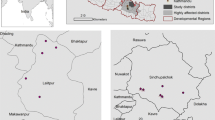Abstract
This article describes the overall damage caused by the May 2008 earthquake in Beichuan County of Sichuan Province in China and the response over the initial three-month ‘Emergency Response and Rescue Period’ as defined by the Chinese government. We hope to inform people by sharing observations and that lessons from the earthquake can be learned in order to make response to similar disasters more effective in future. We used questionnaires to collect data from the County government authorities, including the health bureau, civil affairs bureau, county hospital, and authorities in four townships, four township hospitals, and four village health posts. In addition, we conducted semi-structured interviews with major directors of each department. The catastrophic damage caused by the earthquake attracted rapid and widespread responses from all the departments within the County as well as many external organizations. The inputs from the central government and other provincial and municipal government authorities, external medical teams, voluntary associations, other countries, and international organizations played important roles in minimizing the risk to survivors and maintaining social order. By formulating emergency plans, departments could more effectively fulfill their functions. Additional strategies are required to enhance cooperation and coordination between different sectors, and to help social organizations and the general public actively contribute so that similar disasters can be more effectively dealt with in the future.
Similar content being viewed by others
References
China Center TV News. (2008) Global Morning News, http://vsearch.cctv.com/plgs_play-CCTVNEWSprog_20080707_6366754_1.html, accessed 6 July 2008.
Soberon, G., Frenk, J. and Sepulveda, J. (1986) The health care reform in Mexico: Before and after the 1985 earthquakes. American Journal of Public Health 76: 673–680.
Peleg, K. and Stein, M. (2002) Earthquake disasters: Lessons to be learned. IMAJ 4: 361–365.
Restrepo, H.E. (2000) Earthquake in Colombia: The tragedy of the coffee growing region: Health impact and lessons for the health sector. Epidemiology and Community Health 54: 761–765.
Schultz, C., Koenig, K. and Noji, E.K. (1996) A medical disaster response to reduce immediate mortality after an earthquake. The New England Journal of Medicine 15: 438–442.
MMWR. (2006) Assessment of health-related needs after Tsunami and Earthquake – Three districts, Aceh Province, Indonesia, July-August 2005. JAMA 295 (11): 1240–1244.
Acknowledgements
The authors thank Christopher Scarf (Scarf Associates, Roseville NSW 2069, Australia) for editing this paper. This study was funded by Baseline Investigation of Assessment on Emergent Medical Assistance after Wenchuan Earthquake: a Project of China Health Policy Support Project. (HPSP), which is a Ministry of Health project supported by the UK Department for International Development.
Author information
Authors and Affiliations
Additional information
Editorial Note
Not just response, prevention is needed
One cannot help being impressed by this diligent review of the response to China's 2008, Richter Scale 8.0 earthquake. Surely, You and her team came away with a useful set of lessons for improving responses to major disasters such as earthquakes – events where much of the infrastructure needed to respond is destroyed. The authors speak earnestly about planning responses in advance. But perhaps, it is more than response that is needed.
In countries that lack resources and where the infrastructure such as hospitals, government buildings, and schools are old and infirm, the consequences of earthquakes are multiplied. But China, like Mexico at the time of its major earthquake in September 1985, is a rapidly growing country where new investment is massive and new buildings outnumber old ones. Thus, in addition to planning for disaster responses to earthquakes in seismic zones, protection of people will depend upon enforced requirements that the best earthquake resisting technologies be used when building new structures. Public health is about prevention and protecting the health of the public.
Anthony Robbins, MD, MPA Co-EditorPedro Mas Bermejo, MD Editorial Board Member
The authors studied the response to the catastrophic 2008 earthquake in China, describing the organization and delivery of emergency responses.
Rights and permissions
About this article
Cite this article
You, C., Chen, X. & Yao, L. How China responded to the May 2008 earthquake during the emergency and rescue period. J Public Health Pol 30, 379–394 (2009). https://doi.org/10.1057/jphp.2009.30
Published:
Issue Date:
DOI: https://doi.org/10.1057/jphp.2009.30




